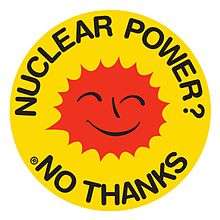Nuclear weapons tests in Australia

The United Kingdom conducted 12 major nuclear weapons tests in Australia between 1952 and 1957. These explosions occurred at the Montebello Islands, Emu Field and Maralinga.[1]
At least two books have been written about nuclear weapons testing in Australia. These include Britain, Australia and the Bomb and Maralinga: Australia's Nuclear Waste Cover-up and My Australian Story: Atomic Testing: The Diary of Anthony Brown, Woomera, 1953.
Sites
The British conducted testing in the Pacific Ocean at Malden Island and Kiritimati known at the time as Christmas Island (not to be confused with Christmas Island in the Indian Ocean) between 1957 and 1958.[2] These were airbursts mostly occurring over water or suspended a few hundred metres above the ground by balloon.[2]
In Australia there were three sites. Testing was carried out between 1952 and 1957 and was mostly done at the surface.[2] A few hundred smaller scale tests were conducted at both Emu Creek and Maralinga between 1953 and 1963.[3]
Maralinga
A testing site at Maralinga was established in 1955, close to a siding along the Trans-Australian Railway. Because supplies could be brought to the site via rail, it was preferred over Emu Creek. A total of seven major tests were conducted at Maralinga. Both the Federal government and Australian newspapers at the time were very supportive of the tests.[4] In 1952, the Liberal Government passed legislation, the Defence (Special Undertakings) Act 1952, which allowed the British Government access to remote parts of Australia to undertake atmospheric nuclear weapons tests. The general public were largely unaware of the risks from the testing program, stemming from official secrecy about the testing program and the remote locations of the test sites.
Before the tests could begin the Maralinga Tjarutja, the traditional Aboriginal owners of the land, had to be removed.[5]
An air base at nearby Woomera, which had been used for rocket testing, was initially used as a base from which planes were flown for testing of the bomb clouds.[5]
| Name | Date[6] | Yield[6] | Type | |
|---|---|---|---|---|
| Operation Buffalo | ||||
| One tree | 27 Sep 1956 17:00 | 12.9 kt | Tower | |
| Marcoo | 04 Oct 1956 16:30 | 1.4 kt | Ground-level | |
| Kite | 11 Oct 1956 14:27 | 2.9 kt | Airdrop | |
| Breakaway | 22 Oct 1956 00:05 | 10.8 kt | Tower | |
| Operation Antler | ||||
| Tadje | 14 Sep 1957 14:35 | 0.93 kt | Tower | |
| Biak | 25 Sep 1957 10:00 | 5.67 kt | Tower | |
| Taranaki | 09 Oct 1957 16:15 | 26.6 kt | Balloon | |
According to Liz Tynan from James Cook University, the Maralinga tests were a striking example of extreme secrecy, but by the late 1970s there was a marked change in how the Australian media covered the British nuclear tests. Some resourceful investigative journalists emerged and political scrutiny became more intense.[7] In June 1993, New Scientist journalist Ian Anderson wrote an article entitled "Britain's dirty deeds at Maralinga" and several related articles.[8]
Opposition
Opposition to the tests grew throughout the 1950s. A poll in 1957 found that almost half the population were against them.[9]
See also
- Downwinders
- Kevin Buzzacott
- List of books about nuclear issues
- McClelland Royal Commission
- Silent Storm (film)
References
- 1 2 Michael Carter et al. (2006). Australian Participants in British Nuclear Tests in Australia, Vol 1: Dosimetry, Commonwealth of Australia, p. 3.
- 1 2 3 United Nations Scientific Committee On The Effects Of Atomic Radiation (2000). Sources and Effects of Ionizing Radiation: UNSCEAR 2000 Report to the General Assembly, with Scientific Annex. United Nations Publications. p. 176. ISBN 9211422388. Retrieved 25 December 2012.
- ↑ Kalmykov, Stepan N. (2010). Actinide Nanoparticle Research. Springer. p. 342. ISBN 3642114326. Retrieved 25 December 2012.
- ↑ Lines, William J. (1991). Taming the Great South Land: A History of the Conquest of Nature in Australia. University of California Press. p. 214. ISBN 0520078306. Retrieved 25 December 2012.
- 1 2 McAuley, Gay (2006). Unstable Ground: Performance and the Politics of Place. Peter Lang. p. 210. ISBN 9052010366. Retrieved 25 December 2012.
- 1 2 "Australian Participants in British Nuclear Tests in Australia 2006 - Dosimetry" (PDF). Australian Department of Veterans' Affairs. p. 7. Retrieved 2008-12-02.
- ↑ Liz Tynan (November 2013). "Dig for secrets: the lesson of Maralinga's Vixen B". Chain Reaction #119.
- ↑ Philip Jones (5 April 2000). "Ian Anderson obituary". The Guardian.
- ↑ Australian Government. A toxic legacy: British nuclear weapons testing in Australia.
External links
- Australian government database of nuclear explosions and tests
- Australian Nuclear Fallout Strontium 90 survey 1957-58 Child bones
- Australia's program of testing for Strontium 90, between 1957 and 1978, samples of children's bones taken at autopsy
- Ionising Radiation and Health
